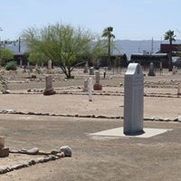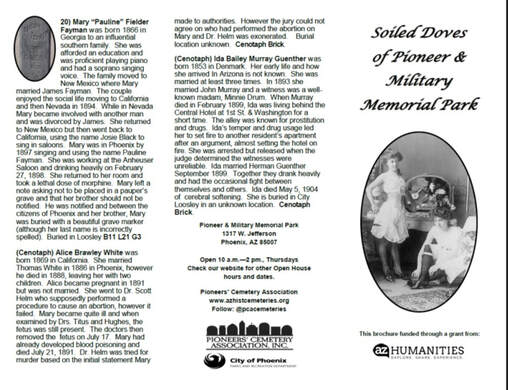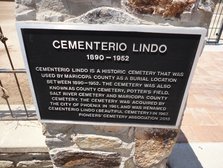Pioneer & Military Memorial Park (P&MMP)

The cemeteries at this location were not the first in Phoenix. During the 1870's, when Phoenix was still a small settlement, burials took place in the 'old' city cemetery which was located approximately between Fifth and Seventh Avenues and Jackson and Madison Streets, near the downtown train station. After Phoenix incorporated as a city on February 25, 1881, citizens and community leaders became concerned that train passengers' first glimpse of Phoenix was a cemetery "right at the door of our beautiful city and in the most irregular, dilapidated, and disgraceful condition...a disgrace to the town" [Daily Herald, 27 May 1884].
To remedy the problem, the fraternal orders of the city purchased Block 32, Neahr's Addition, keeping the east half to establish their own cemeteries and selling the west half to others for cemetery use. Families moved their loved ones from the old cemetery to the new one, and the City reburied the unclaimed bodies in a common grave.
The Pioneer & Military Memorial Park is comprised of seven historic cemeteries which were in use between 1884 and 1914. You may find who is buried in our cemeteries by using the links below to Find A Grave.
Please be aware that the death records naming the burial place may have used different names for the same cemetery. Loosley and City Cemetery refer to the same cemetery. Rosedale is sometimes called Loring or Walker. The GAR and Confederate (or ex-Confederate) cemeteries are both sections of Porter Cemetery.
Records show that between two and three hundred burials were later moved from these cemeteries, the majority of them to what is now Greenwood Memory Lawn. In most cases, the markers were also moved to the new burial site. Although contemporary death records will still show the original cemetery, the graves themselves are now located elsewhere. After a law forbidding further burials within city limits went into effect in 1914, the cemeteries were declared closed. They fell into disrepair until private citizens rallied decades later to restore them.
In May 1988, the seven historic cemeteries were officially designated as the Pioneer & Military Memorial Park with the dedication of the Avenue of Flags and the new fence. Over the years, visitors from all over the United States and several foreign countries have come to pay their respects to Phoenix's pioneers. Among the notables buried here are Darrell Duppa, King Woolsey and Jacob Waltz.
To remedy the problem, the fraternal orders of the city purchased Block 32, Neahr's Addition, keeping the east half to establish their own cemeteries and selling the west half to others for cemetery use. Families moved their loved ones from the old cemetery to the new one, and the City reburied the unclaimed bodies in a common grave.
The Pioneer & Military Memorial Park is comprised of seven historic cemeteries which were in use between 1884 and 1914. You may find who is buried in our cemeteries by using the links below to Find A Grave.
- Ancient Order of United Workmen (AOUW)
- Independent Order of Odd Fellows (IOOF)
- Knights of Pythias (K of P)
- City/Loosley
- Masons
- Porter
- Rosedale
Please be aware that the death records naming the burial place may have used different names for the same cemetery. Loosley and City Cemetery refer to the same cemetery. Rosedale is sometimes called Loring or Walker. The GAR and Confederate (or ex-Confederate) cemeteries are both sections of Porter Cemetery.
Records show that between two and three hundred burials were later moved from these cemeteries, the majority of them to what is now Greenwood Memory Lawn. In most cases, the markers were also moved to the new burial site. Although contemporary death records will still show the original cemetery, the graves themselves are now located elsewhere. After a law forbidding further burials within city limits went into effect in 1914, the cemeteries were declared closed. They fell into disrepair until private citizens rallied decades later to restore them.
In May 1988, the seven historic cemeteries were officially designated as the Pioneer & Military Memorial Park with the dedication of the Avenue of Flags and the new fence. Over the years, visitors from all over the United States and several foreign countries have come to pay their respects to Phoenix's pioneers. Among the notables buried here are Darrell Duppa, King Woolsey and Jacob Waltz.
Walking Tour Brochures of P&MMP

Thanks to a grant from Arizona Humanities, Pioneers' Cemetery Association is proud to make these brochures available for your reference and use! Enjoy the stories of those that came before us! Print them to share or use them on your next self-guided tour of our historic cemeteries.
Cementerio Lindo

Between 1890 and 1951, more than seven thousand early Phoenix residents were buried in the first Maricopa County Cemetery (also known as the Salt River Cemetery) now located at South 15th Avenue and Durango, just north of the I-17 freeway. They were tuberculosis patients, indigents, children and "just plain folks".
In 1890 the Maricopa County Board of Supervisors accepted a bid of $1,250 in County scrip for ten acres of land for a paupers’ burial ground. The first burial is believed to have taken place in 1891.
A 1943 survey shows that there were 1,339 markers at that time. One headstone carried birth and death dates of 1868-1913. That headstone has since disappeared.
The cemetery was closed to new burials in 1951. Around 1961, Maricopa County deeded the property to the City of Phoenix and it was renamed Cementerio Lindo. In 1967, workers employed under the City's LEAP program beautified the cemetery with shrubs and trees. Between 1990 and 1992, annual remembrance ceremonies complete with mariachi bands were held there.
Photographs show that until the mid-1990's, the cemetery had trees and grass. However, when the irrigation system failed, the appearance of the cemetery began to deteriorate. The trees died, and runoff from the adjacent freeway buried some of the headstones under several inches of mud.
Nevertheless, the dead have not been forgotten. Bouquets of flowers continue to appear year after year on the graves that were still identifiable. A news article which appeared in the April 27, 2007 edition of the Arizona Republic newspaper generated additional publicity.
To combat the neglect and vandalism of the remaining headstones, the City of Phoenix Parks and Recreation Department is working with Pioneers' Cemetery Association (PCA) to improve conditions at Cementerio Lindo. As with any project of this nature, public support--your support--is needed. Descendants and relatives of those buried in Cementerio Lindo can contact their city council persons to demonstrate their support for the rehabilitation of Cementerio Lindo.
In 1890 the Maricopa County Board of Supervisors accepted a bid of $1,250 in County scrip for ten acres of land for a paupers’ burial ground. The first burial is believed to have taken place in 1891.
A 1943 survey shows that there were 1,339 markers at that time. One headstone carried birth and death dates of 1868-1913. That headstone has since disappeared.
The cemetery was closed to new burials in 1951. Around 1961, Maricopa County deeded the property to the City of Phoenix and it was renamed Cementerio Lindo. In 1967, workers employed under the City's LEAP program beautified the cemetery with shrubs and trees. Between 1990 and 1992, annual remembrance ceremonies complete with mariachi bands were held there.
Photographs show that until the mid-1990's, the cemetery had trees and grass. However, when the irrigation system failed, the appearance of the cemetery began to deteriorate. The trees died, and runoff from the adjacent freeway buried some of the headstones under several inches of mud.
Nevertheless, the dead have not been forgotten. Bouquets of flowers continue to appear year after year on the graves that were still identifiable. A news article which appeared in the April 27, 2007 edition of the Arizona Republic newspaper generated additional publicity.
To combat the neglect and vandalism of the remaining headstones, the City of Phoenix Parks and Recreation Department is working with Pioneers' Cemetery Association (PCA) to improve conditions at Cementerio Lindo. As with any project of this nature, public support--your support--is needed. Descendants and relatives of those buried in Cementerio Lindo can contact their city council persons to demonstrate their support for the rehabilitation of Cementerio Lindo.
Sotelo-Heard Cemetery
Another historic cemetery we're aware of in downtown Phoenix is Sotelo-Heard Cemetery. According to a report in 1995 and revised in 1997, this is a "land locked" cemetery as it is located in the center of a city block with no road access. According to this report, this is "a Historic period Mexican cemetery, apparently used prior to 1896 and as late as 1922." Up to 177 burials here have been identified. This is known as a burial site for Heard Ranch hands and their families. As occasional efforts are made to restore the grounds, Pioneers' Cemetery Association is contacted as an information resource.
Known Burial Sites in Arizona
Historic cemeteries preserve essential information for local historians, family genealogists and the general public. The Pioneers' Cemetery Association (PCA) defines an 'historic cemetery' as one which has been in existence for more than fifty years. Today, Arizona's historic cemeteries are maintained and administered by a wide variety of private and public agencies. A list of sites is available below.
| Known Burial Sites in AZ | |
| File Size: | 190 kb |
| File Type: | |
Cemeteries in Maricopa County
Several of these cemeteries have already been recorded and their lists of burials published on the internet such as Find A Grave. Please be aware, however, that these transcriptions may not be complete or up-to-date.
| Cemeteries in Maricopa County | |
| File Size: | 170 kb |
| File Type: | |
Pioneers' Cemetery Association
Copyright 2017
Contact Webmaster for website concerns.
All Rights Reserved
Copyright 2017
Contact Webmaster for website concerns.
All Rights Reserved
